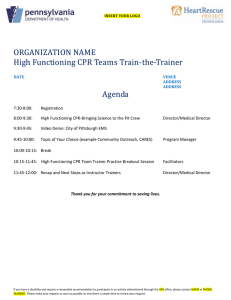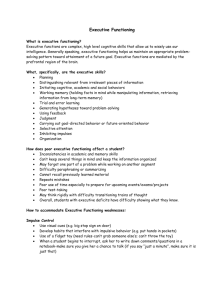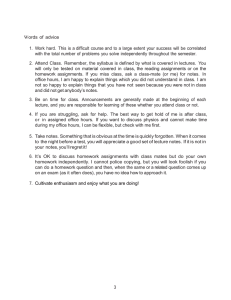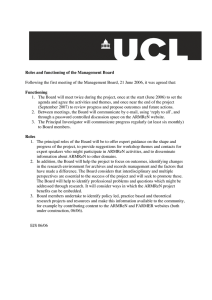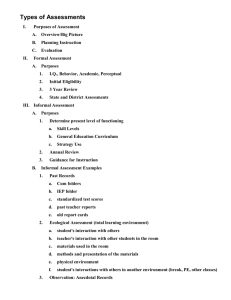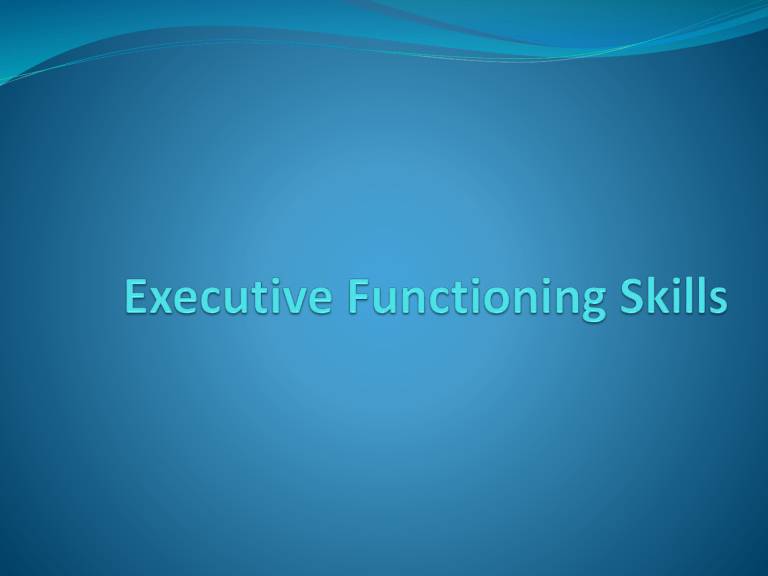
What is Executive Functioning? A set of mental skills that are coordinated in the brain's frontal lobe. Executive functions work together to help a person achieve goals. We use executive functioning when we plan, organize, strategize, pay attention, and remember details. Development of Executive Functioning Skills Executive functioning is slow to fully develop. It emerges in late infancy, goes through marked changes during the ages of 2 through 6, and does not peak until around age 25. Therefore, it is important for children to be provided with strategies and adult support in order to help them acquire these skills. Executive Functioning Difficulties Planning Organizing Materials and Space Time Management Working Memory Initiating Tasks Difficulties can be seen at any age but tend to be increasingly apparent during the elementary grades as the demands of school work increase. How Can Executive Functioning Affect Learning? Trouble initiating and completing tasks in a timely manner. Difficulty generating ideas independently. Difficulty retaining information that is required to complete a task. Difficulty in communicating details in an organized, sequential manner (i.e., orally and/or in writing). Struggles to understand the planning that is needed to complete a project. Executive Function: Inhibition Ability to stop one’s own behavior at the appropriate time, including stopping actions and thoughts (i.e., impulse control). Examples: Student interrupting their parents when they are on the telephone. Student unable to complete homework because of video games/YouTube. Strategies for Inhibition The use of visual cues can be highly effective for this deficit area. Some examples may include: stop sign, hand signals, pictures of ‘quiet mouth,’ traffic light Use of a fidget toy or object. Some examples include: Tangle, velcro, squishy ball, fun-tac/ therapy putty When a child begins to interrupt, ask them to write down their comments/questions. In order for this strategy to be effective, make sure you give the child time to talk about what they have written. Executive Function: Shifting Ability to move freely from one situation to another and to think flexibly in order to respond appropriately to the situation. Example: Your child does not want to stop playing their video games and begin their homework. Strategies for Shifting Provide warnings as to when the transition will occur (i.e., “In 5 minutes, I need you to clean up your toys and begin your homework.”) The use of visual timers. This strategy provides a nonverbal warning and helps children understand the concept of time. Schedules can be used to prepare your child for the series of activities they need to complete while at home. Based on your child’s developmental level and ability, a visual schedule (i.e., with pictures) may be useful. Executive Function: Initiation Ability to begin a task or activity and to independently generate ideas, responses, or problem solving strategies. Example: You tell your child to begin their homework and when you check-in 5 minutes later, no work has been completed. Strategies for Initiation Provide adult assistance with the first item to ensure the child understands the task demands. For writing tasks, the use of graphic organizers may be helpful in formulating their ideas. Initially, have a brief discussion with your child in order to brainstorm ideas/responses before your child begins working independently. Provide incentives when asking your child to engage in non-preferred activities (i.e., chores and homework). Executive Function: Working Memory Capacity to hold information in your mind for the purpose of completing a task. Example: When you ask your child to complete multi- step directions (e.g., brush your teeth, get dressed, and come downstairs for breakfast). Strategies for Working Memory Repeat orally presented information. Simplify the language in directions. Chunk/break down multi-step directions. Use of mnemonics or other strategies to help remember a series or other information. Use visualization strategies to enhance recall. Executive Function: Planning/Organization Ability to manage current and future-oriented task demands. Also includes the ability to impose order on work, play, and storage spaces. Example: You are bringing your child to football practice and ask them to gather all of their necessary materials before it is time to leave. Strategies for Planning/Organization The use of checklists is highly effective in increasing organizational skills. The use of a calendar for upcoming activities and/or assignments. Color coding books/folders by subject area. Breakdown long-term assignments into smaller components and set deadlines accordingly. Designate a quiet and clean space for your child to complete their homework or other tasks. Executive Function: Self-Monitoring Ability to monitor one’s own performance and to measure it against some standard of what is needed or expected. Example: You ask your child to complete their math assignment and then check it for accuracy. Strategies for Self-Monitoring Use of a calculator can be used to ensure accuracy of math assignments. The use of a checklist to explicitly denote all steps necessary to complete the task. Creating checkpoints to ensure comprehension of presented material (e.g., when you get to #5, check-in with me). The use of visuals (e.g., red/green to indicate whether your child fully understands or needs assistance). Questions?


